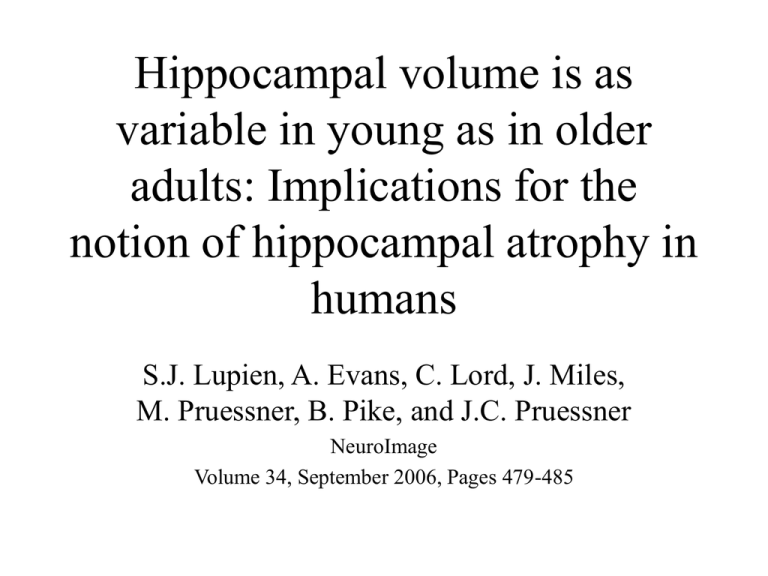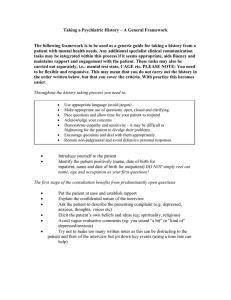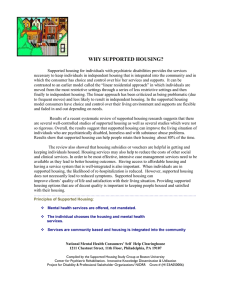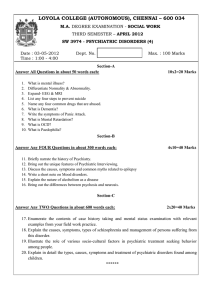Hippocampal volume is as variable in young as in older
advertisement

Hippocampal volume is as variable in young as in older adults: Implications for the notion of hippocampal atrophy in humans S.J. Lupien, A. Evans, C. Lord, J. Miles, M. Pruessner, B. Pike, and J.C. Pruessner NeuroImage Volume 34, September 2006, Pages 479-485 The hippocampus •Located bilaterally inside the temporal lobe •Forms a part of the limbic system • Plays a part in memory and spatial navigation. Hippocampal Volume •Age Dependant on: •Psychiatric Disease (schizophrenia, depression, PTSD) •Pre-determined Individual difference? Fig. 1. Schematic representation of the implicit assumption resulting from the aging model. S.D.: standard deviation. Hypothesis If aging and psychiatric disease lead to HC atrophy in adult humans, it is implied that the HC volume in young healthy adults should present less variability than HC volume in older adults and psychiatric populations. Subjects •177 men and women aged 18-85 years (70 men and 107 women) •Participants were screened for history of neurological disorder, psychiatric disorder, head trauma and conditions preventing MRI assesment •Participants with a psychiatric disorder, or participants using antiseizure medication, antihypertensive medication, anxiolytics or antidepressants were excluded from the study. •Older patients were further screened for dementia and depression using the Blessed Information-MemoryConcentration Test and the Geriatric Depression Questionaire MRI image acquisition and analysis •Participants were split into 5 age groups of approx. 40 individuals per group. •Age groups were: 18-24 years 25-40 years 41-59 years 60-75 years 76-85 years* (Only 16 individuals in this group) MRI image acquisition and analysis •All images were transferred to a silicon Graphics workstation •A combination of different algorithms was used to prepare the raw MRI volume for manual segmentation. •Processing steps included: non-uniformity correction, translation into standard stereotaxic space, and signal intensity normalization. Assessment of HC volume •Principle orientation for the segmentation of the HC was the coronal view for the tail and body of the HC, and the axial view for the head. •HC was segmented from posterior to anterior in the coronal view, and superior to inferior in the axial view. •Does not comprise the amygdala Results Fig. 2. Scatterplot of the association between age and HC volumes in males and females. Results Mean HC volume (cubic centimeters) and standard deviation in 177 men and women aged from 18 to 85 years Age Range N Total Mean Min HC Volume Max HC Mean/lowes % Volume t Quartile difference b/w means 18-24 41 4.23 +/- 0.36 3.65 5.13 3.82 +/- 0.12 12 25-40 38 4.13 +/- 0.48 3.31 5.12 3.55 +/- 0.13 16 41-59 42 3.97 +/- 0.36 3.07 4.96 3.56 +/- 0.18 12 60-75 40 3.78 +/- 0.46 2.89 4.54 3.28 +/- 0.20 15 76-85 16 3.20 +/- 0.48 2.57 4.26 2.64 +/- 0.08 21 Results •Analysis established that there are differences in mean HC volume associated with chronological age •Using Whites test it was established that there is no evidence of different variance in different age groups •HC volume is therefore as variable in younger as in older adults, although mean HC volume is smaller is older groups when compared to younger groups Results • % difference between the mean HC volume of each age group and the mean HC volume of the lowest quartiles in each age group were analyzed •Results showed that within the same age group, the % difference between the mean HC volume and the mean of the lowest quartile of each group ranges from 12-21% •This % is greater than the % differences of HC volume reported in patients suffering from psychiatric disorders compared to age matched controls. Discussion •Results show that the dispersion around the mean of the HC volume is not different in young and older adults •25% of 18-24 year old subjects present HC volumes as small as those observed in the average older adults aged 60-75 years. •Therefore it is possible that the HC volume at any given age reflects a volume that was predetermined based on early experiences Discussion •HC “atrophy” due to the presence of a psychiatric disease could in fact represent pre-determined inter-individual differences in HC volume that increase vulnerability to stress and/or mental disorders. •Case study: Monozygotic Twins and PTSD -Study in 2002 -HC volume may be a pre-existing condition that increases vulnerability to PTSD upon exposure to a traumatic experience Discussion More Evidence: •Other studies have revealed smaller HC volume in first-episode untreated depressed patients and first-episode untreated schizophrenics •Finding goes against any neurotaxic effect of depression and/or schizophrenia on HC volume •Suggests that individual differences in HC volume may render individuals more or less vulnerable to the effects of stress and cognition on mental health Factors influencing HC Volume •Genetics (40%) •Experience (60%) Experience factors influencing growth of HC volume: -Environmental enrichment * -Nutritional factors* -Stress (cortisol)* -Gestational stress *inducers of changes in neurogenesis and/or dendritic arborization influencing HC volume Conclusions •HC volume is as variable in young as in older adults •Smaller HC volume attributed to the aging process in previous studies could actually represent HC volume early in life. •Within similar age groups there is as much variation in HC volume of healthy subjects as can be found when comparing the HC volume of psychiatric patients and age matched controls Conclusion Therefore: pre-determined individual differences in HC volume in humans may determine the vulnerability for age-related cognitive impairments or psychopathology throughout the lifetime.






